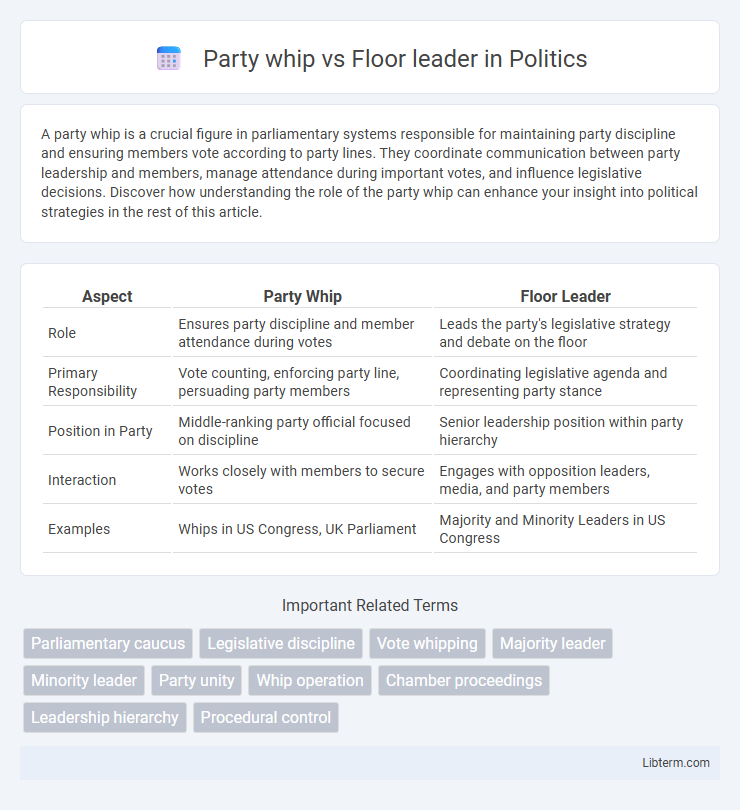A party whip is a crucial figure in parliamentary systems responsible for maintaining party discipline and ensuring members vote according to party lines. They coordinate communication between party leadership and members, manage attendance during important votes, and influence legislative decisions. Discover how understanding the role of the party whip can enhance your insight into political strategies in the rest of this article.
Table of Comparison
| Aspect | Party Whip | Floor Leader |
|---|---|---|
| Role | Ensures party discipline and member attendance during votes | Leads the party's legislative strategy and debate on the floor |
| Primary Responsibility | Vote counting, enforcing party line, persuading party members | Coordinating legislative agenda and representing party stance |
| Position in Party | Middle-ranking party official focused on discipline | Senior leadership position within party hierarchy |
| Interaction | Works closely with members to secure votes | Engages with opposition leaders, media, and party members |
| Examples | Whips in US Congress, UK Parliament | Majority and Minority Leaders in US Congress |
Introduction to Party Whip and Floor Leader
The Party Whip is responsible for maintaining party discipline, ensuring members vote according to party lines, and coordinating communication between the party leadership and rank-and-file members. The Floor Leader manages the legislative agenda, orchestrates debate strategies, and represents the party in negotiations on the legislative floor. Both roles are crucial for efficient party operations but serve distinct functions in legislative processes.
Definition of Party Whip
The Party Whip is a key political official responsible for maintaining party discipline, ensuring members vote according to party policies, and managing legislative agendas within a legislature. This role involves coordinating communication between party leaders and rank-and-file members, tracking attendance, and enforcing voting instructions. In contrast, the Floor Leader acts as the primary spokesperson and strategist for the party on the legislative floor, focusing on debate management and legislative priorities.
Definition of Floor Leader
The Floor Leader, also known as the Majority or Minority Leader, is the primary spokesperson and strategist for a political party within a legislative assembly, responsible for managing party agendas and negotiating legislative priorities. In contrast, the Party Whip assists the Floor Leader by enforcing party discipline, ensuring member attendance, and securing votes for key legislation. The Floor Leader holds a higher rank and broader leadership role, orchestrating overall party strategy on the legislative floor.
Historical Evolution of Both Roles
The roles of Party Whip and Floor Leader have evolved significantly since their origins in parliamentary systems during the 18th century, with the Party Whip emerging primarily to ensure party discipline and manage voting behavior. Floor Leaders developed as key strategists and spokespersons, coordinating legislative agendas and negotiations within the chamber. Over time, both positions have adapted to increasing party complexities and legislative demands, solidifying their importance in maintaining party cohesion and legislative effectiveness.
Core Responsibilities of a Party Whip
The core responsibilities of a Party Whip include maintaining party discipline, ensuring attendance for votes, and communicating the party leadership's position on legislation to members. Party Whips coordinate voting strategies to secure support for the party's agenda and act as a liaison between the party leadership and rank-and-file members. Unlike the Floor Leader, who primarily manages the party's overall legislative strategy and debate, the Whip's focus is on detailed vote counting and member coordination.
Key Duties of a Floor Leader
Floor leaders coordinate legislative strategy, manage party debate, and liaise between party members and leadership to ensure smooth passage of bills. They schedule floor activities, communicate party positions, and rally votes to maintain party discipline during crucial votes. Unlike party whips who focus on vote counting and member persuasion, floor leaders play a broader role in directing legislative agenda and maintaining cohesion among party members.
Differences Between Party Whip and Floor Leader
The party whip is responsible for enforcing party discipline, ensuring members vote according to party lines, and managing internal communication within the legislative body. In contrast, the floor leader primarily strategizes legislative agendas, represents the party during debates, and leads negotiations with opposing parties. While the whip focuses on member compliance, the floor leader directs overall party tactics and legislative priorities.
Importance of Coordination Between Both Roles
Party whips and floor leaders play crucial roles in legislative bodies, where effective coordination ensures party discipline and strategic legislative action. Party whips are responsible for mobilizing votes and maintaining member compliance, while floor leaders set the legislative agenda and guide debate. Seamless collaboration between these roles optimizes decision-making efficiency and strengthens party unity during legislative sessions.
Impact on Legislative Process
Party whips enforce discipline among party members, ensuring votes align with party priorities, which streamlines the legislative process by minimizing dissent and facilitating smoother passage of bills. Floor leaders coordinate legislative strategy, negotiate with opposition and other party members, and schedule debates, directly influencing the legislative agenda and timing. Together, they shape policy outcomes by managing party cohesion and controlling the flow of legislation through parliamentary procedures.
Conclusion: Choosing Between Party Whip and Floor Leader
Choosing between a party whip and a floor leader depends on the strategic needs of a political party within legislative processes. Party whips specialize in maintaining discipline, securing votes, and ensuring legislative alignment among party members. Floor leaders, by contrast, focus on managing party strategy during floor debates and representing the party's interests in legislative negotiations.
Party whip Infographic

 libterm.com
libterm.com